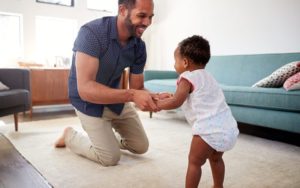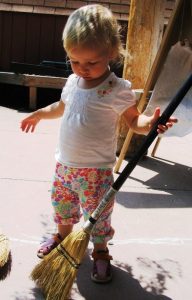Sunday, June 12, 2022

As easily as we take for granted the ability to stand and walk about freely through our day, all it takes is watching an infant in the gravity-defying act of standing upright for the first time to feel the amazement it deserves. When we observe our little ones moving through this long, arduous process we come to appreciate it newly. Of course, not long afterwards, we are also looking back fondly at the days someone wasn’t running laps around our ankles for hours!
It is an extraordinary event, nonetheless, for all that is involved in coming to stand and walk. Allowing our babies to come to this milestone freely, and to explore it freely as often as possible is essential in supporting their sense of self-movement. If we consider a simple view of the steps they had to move through in order to get there and to keep going, perhaps it will inspire some patience for those constant movers.
To begin with, every baby is born with several involuntary reflexes that stimulate the development of movement patterns throughout the first year of life. These involuntary reflexes are integrated as a baby moves in a particular way, over and over and over again, gaining more control over the reflex each time. As free movement is encouraged and supported, these reflexes give way to more complex movement patterns that carry us through life. Many of these reflexes and their integration, essentially get us to standing and walking!
Once standing, a toddler will begin integrating their horizontal midline, which separates the spatial experience of the above-below plane of space. Set to walking, they begin working with the forward-backward plane and left-right plane, integrating other midlines as well, especially as their walk becomes fluidly crosslateral. In cooperation with a growing sense of balance, their movement allows them to increase awareness of how to orient within the world.
A healthy way to support this new found skill, is of course by offering plenty of opportunities for its development. Walking with consistency- perhaps a built in morning walk, walking on a variety of surfaces in barefeet, walking along curbs or from rock to rock, and so forth. As children grow it is also and simply beneficial to support their sense of movement by helping them to be intentional with it; growing their self-awareness in how it relates to their body.
 In some ways, this is done when we invite children into completing specific tasks around the house or school. They naturally bring awareness to their movement when they are learning a specific task. But I can see how it can be supported in other developmentally appropriate, imaginative ways. We would never want to tell the children directly, “we must swing our arms back and forth and stand upright like this as we walk,” for example.
In some ways, this is done when we invite children into completing specific tasks around the house or school. They naturally bring awareness to their movement when they are learning a specific task. But I can see how it can be supported in other developmentally appropriate, imaginative ways. We would never want to tell the children directly, “we must swing our arms back and forth and stand upright like this as we walk,” for example.
I am considering how to bring more of this intentionality to my kindergarteners (3-7 year olds) this Fall. There was a time when it was natural for young children to imitate the adult who was moving; however, in our current culture, permeated with overwhelm, many children are losing this capacity to imitate. As I reflected on it before bed recently, a lovely possibility came to me. I would start with a verse within circle time- one that I learned many years ago at Rose Rock School. It begins:
A little child went walking, one lovely summer’s day.
I would start by walking myself in a beautiful way as the children follow. Then, after a few moments, I might pause and say, “I imagine on a beautiful summer day that this child will have a beautiful walk, too. Who can show me what a beautiful walk looks like?” I would give some of the children a chance, one at a time, to show their beautiful walk, and then we would all bring the beautiful walk I modeled to our circle. It continues:
She saw a little rabbit who quickly hopped away!
She saw a shining river, winding in and out,
And little fishes in it were swimming all about.
I would bring the same kind of question and intentionality to the other movements of a rabbit hop, a winding river, and swimming fishes; but I would model each one before opening it up to the children to share their movements. Although it is true that children do not imitate like they used to, some still do. In fact they often enjoy imitating the child who is slightly out of bounds in their behavior. So if we have not first set the example, and one of the children decides to “model” something completely silly, it may take awhile to bring the group back toward the idea of beautiful movement.
Lastly, we end the poem with this last stanza and a beloved game featuring the song, “Pigeon House.”
She saw a bridge above the water and when she stopped to rest,
She saw a dear old woman tending her pigeons’ nest.
I imagine after bringing this circle game to them, that I could use the little child from the verse for reference on our morning walks- “Do you remember how beautifully the little child walked on her summer day? Let’s walk like that for this part of the path.”
Children today are entrenched in a culture that draws them out of themselves and into an intellectual space that is often not even being fully digested because it’s presented to them through screens. Some of the greatest gifts we can give them are opportunities like this to come into their bodies, wholly and joyfully.
How do you envision supporting the sense of self-movement through intentionality?
